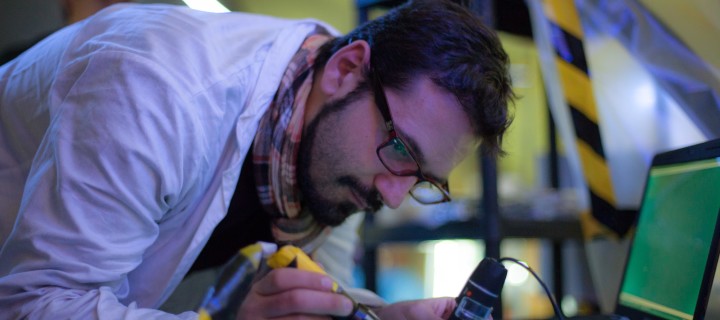In this larp we didn’t have restrictions. We just wanted to organize the coolest larp ever played in Italy. At least, that’s what I wanted.
Chiara Tirabasso is one of the many larpwrights behind Black Friday. She perfectly sums up two elements of the organizing team: a great ambition on quality for this larp and a strong authorship.
The game was played two times in November 2014 and totalled 140 players. Looking at reactions and feedback from all of them based upon surveys on player satisfaction, one can be pretty sure that Black Friday was a remarkable larp for the Italian scene for many reasons.
First of all, it was a high-budget larp written in the Nordic tradition, which is getting more and more attention, but is still quite uncommon in Italy. The larp was also heavy on technology and scenery. But the most important feature in its design was the organizing team, which comprised people from very different associations and traditions, as well as “lone wolves” and even newbies to larpwrighting. For this reason, this article will discuss this larp through the voices of some of the people behind it in interview style.
The Beginning
 “It all started during Larp Symposium 2013,” explains Francesco Pregliasco the project coordinator. Larp Symposium is a yearly meeting of larpers and the Italian equivalent of Knudepunkt. “Some organizers from Chaos League, Cronosfera, and Terre Spezzate met and realized that everyone was interested in working together. There was mutual respect.”
“It all started during Larp Symposium 2013,” explains Francesco Pregliasco the project coordinator. Larp Symposium is a yearly meeting of larpers and the Italian equivalent of Knudepunkt. “Some organizers from Chaos League, Cronosfera, and Terre Spezzate met and realized that everyone was interested in working together. There was mutual respect.”
Mario Di Cintio elaborates, “On the occasion of Larp Symposium, I had the chance to know a lot of different associations. Each of them sees larp in a different way than mine. But still, everyone had the will to share their experiences. Hadn’t there been that meeting for knowing each other, I’d never had the grounds to think this project feasible.”
Aladino Amantini continues, “We wanted to accomplish something new. Something that could raise the quality level from the larps that we had organized until that moment. At least in my case, enthusiasm brought me to the synergy.”
But why look for new partners in organizing such a high expectations event? Wouldn’t it be easier to rely on a well-established team?
 Alessandro Giovannucci, explains, “Matching with other people helps you [find] new ways. You can get inspiration from every source, but larp is a performative art like music or theatre, so it also needs practice. And you can improve it only by doing things together. You learn jazz by taking part in jam sessions, not reading books. That said, theory must not be overshadowed: most of the bad larps had too few [thoughts] behind them. My organizing team, Chaos League, has more than 20 years of experience, with a strong identity in style. But working with others is very interesting, useful, and funny. I [taught] and I learned. I hope that in Italy, we’ll have more projects like that. It’s a hard way and not many people went through it before, but the renewal of the national larp scene can begin also here.”
Alessandro Giovannucci, explains, “Matching with other people helps you [find] new ways. You can get inspiration from every source, but larp is a performative art like music or theatre, so it also needs practice. And you can improve it only by doing things together. You learn jazz by taking part in jam sessions, not reading books. That said, theory must not be overshadowed: most of the bad larps had too few [thoughts] behind them. My organizing team, Chaos League, has more than 20 years of experience, with a strong identity in style. But working with others is very interesting, useful, and funny. I [taught] and I learned. I hope that in Italy, we’ll have more projects like that. It’s a hard way and not many people went through it before, but the renewal of the national larp scene can begin also here.”
Francesco Pregliasco continues, “For a long time, I had the ambition to make a particularly well-crafted larp in [collaboration] with others, so that we could get the support from [the] skills, energy, and contacts that we wouldn’t have on our own. This ambition has never been satisfied – I didn’t know other teams or [a] single people who could organize events even remotely near ours, quality-wise. Also, a few months [before], I played Monitor Celestra, that incredible Battlestar Galactica Swedish larp. It was a colossal [event] organized by several larp groups cooperating together, and I was very impressed by that.”
Mario Di Cintio elaborates, “Personally I sensed, since the beginning, that this project would have enhanced larp development in Italy and contributed to [writing] a piece of its history. For a long time, I hoped [for] the chance of doing something choral. Something different from usual larps and, most [importantly], disconnected from the dynamics of the biggest larp events in Italy.”
Themes, Plot and Organization
 Black Friday defined itself as a “technology enhanced thriller.” It was set in a mining town during an emergency – the authors begged us not to disclose which kind of emergency, in order to avoid spoilers. The themes explored in this larp were the deprivation of civil liberties, struggling with the great fears of the modern world, and choosing between “peace and violence, ethics and progress, individualism and common good, protection and freedom.”
Black Friday defined itself as a “technology enhanced thriller.” It was set in a mining town during an emergency – the authors begged us not to disclose which kind of emergency, in order to avoid spoilers. The themes explored in this larp were the deprivation of civil liberties, struggling with the great fears of the modern world, and choosing between “peace and violence, ethics and progress, individualism and common good, protection and freedom.”
As Francesco Pregliasco describes, “The very first idea of Black Friday was, something went wrong in a small American mining town – but what’s behind [it]?’ I think it was an idea from Fabio Bracciolini during an evening where we were chatting about interesting concepts for larp. Fabio had never organized nor written a larp.”
Chiara Tirabasso elaborates, “Even before forming the team, I was already liking a lot of the themes that we developed [earlier]. I think that once we agreed on the main idea, the themes just sprung [up] naturally. The first time we wrote down a list of TV series and movies for inspiration, it seemed like we had already reached a previous agreement! We were absolutely [attuned]. The winning choice was to put together writers and crew so that we could cover all the very different skills we needed to set up Black Friday. Not only character, scenario, and plot writing; but also webmastering; filming dozens of videos; programming a database and other diegetic software; and so on.”
 Lorenzo Giannotti states, “I’m very proud. Black Friday was thought [out] with a complex structure with different game styles for each of the player groups. Miners, scientists, and law enforcers had very different rhythms and dynamics, and all of them merged into a whole, synergic storytelling. The scientists had [a] frenetic pace, repetitiveness, pressures from above, and moral choices. The miners had a more ‘classic’ game, mostly made of drama and experiences; they were scarred by suffering, oppression, [the] search for answers, and glimpses of hope. They also had most of the backstory, [which] the other group could understand with interrogations or searches. The law enforcers, finally, played a more physical game or an investigation game, depending on the role of each character in team; their drama was given by steady pressure from above, so that they could have moral dilemmas. Somehow, they were three different but synergic larps. A lot of players said that they’d like to play again in a different group.”
Lorenzo Giannotti states, “I’m very proud. Black Friday was thought [out] with a complex structure with different game styles for each of the player groups. Miners, scientists, and law enforcers had very different rhythms and dynamics, and all of them merged into a whole, synergic storytelling. The scientists had [a] frenetic pace, repetitiveness, pressures from above, and moral choices. The miners had a more ‘classic’ game, mostly made of drama and experiences; they were scarred by suffering, oppression, [the] search for answers, and glimpses of hope. They also had most of the backstory, [which] the other group could understand with interrogations or searches. The law enforcers, finally, played a more physical game or an investigation game, depending on the role of each character in team; their drama was given by steady pressure from above, so that they could have moral dilemmas. Somehow, they were three different but synergic larps. A lot of players said that they’d like to play again in a different group.”
Obviously, putting together a complex project like this requires a strict organization of the team.
Aladino Amantini explains, “We had different groups. Mine had to write characters and plots; others worked on scenery, supervised the logistics, controlled the budget, worked on promoting the event. There’s been a strong supervision so that the groups could match their deadlines and give all the results to proceed with the overall job.”
Alessandro Giovannucci continues, “The project had two complimentary souls, at least to me. The community brainstorm one — magmatic and chaotic – and the rigid one, where we divided into groups with hard deadlines. Every member of the team was both chaotic and rigid. This allowed us to put together ideas and suggestions, but at the same time to put them into practice. The larp development was based on the purpose of a mature and entertaining event that could leave a lasting impression on the players. And to the organizers, too!”
Chiara Tirabasso states, “We worked on this larp since January. Softly in the first months, than speeding up while we were getting closer to the gaming date. I think that [this has] been the right time and pace to agree on the themes; otherwise it wouldn’t have been the same thing. We indulged in having only choices [that] we agreed upon, like we were a well-adjusted team instead of a completely new one.”
Technology Advancements
 As said above, one of the main features of the game was technology. This choice added verisimilitude, but also a further level of complexity.
As said above, one of the main features of the game was technology. This choice added verisimilitude, but also a further level of complexity.
Francesco Pregliasco elaborates, “A truly unique feature for basically every player was the abundance of gadgets to interact with, and the quality of scenery and props. Our comparatively high budget, the hard work from the scenery team, and some [rentals] allowed us to have a remarkable bunch of computers, uniforms, walkie-talkies, cars, special fx, telephones, cameras, microscopes…”
Marco Ascanio Viarigi agrees. “We had very high production values. We put into the game interactive videos, interfaces where players could enter data (and have a response), pre-registered communications… During the larp, we used technology to let some phone [calls] arrive from the outside. There were also “satellite video chats” with fake backgrounds that let us introduce characters not physically there, but still in game through the screen.”
Chiara Tirabasso recounts, “In the first run, the bad weather struck our scientists’ lab. The computer we had in there broke and the strong wind nearly uprooted the whole lab! We had to move it in the heart of the night, as part of the game, thanks to help from scientist characters and staff members disguised as lab technicians. In a few hours, it all went well, but how exhausting!”
 Michele Pupo elaborates, “One of the criticalities was science. On one hand, we had to have a strong plot, scientific enough to be believable. On the other hand, the story had to be playable without too much procedural accuracy. We did a lot of [research] and tweaks; the purpose was to make every procedure actually playable and entertaining. The second challenge about science was having scientists as player characters, which unavoidably generated criticisms. We had to try and make believable scientists with players [who] hadn’t studied the subject…their whole life. We had workshops and written texts to give them at least the basic information and the right jargon, but a lot of work came from the players themselves who studied in advance! The result was quite good. Of course, someone noticed that a scientist or two dropped some nonsense… but I think you can’t overcome this without…yearly preparation. In fantasy larps, this isn’t a problem, while we find it in contemporary settings. In fantasy games, meeting highly specialized characters is very rare, and usually our basic [knowledge is] enough. Conversely, every contemporary larp has problems with highly specialized roles. Even…so, I think we managed to operate very well.”
Michele Pupo elaborates, “One of the criticalities was science. On one hand, we had to have a strong plot, scientific enough to be believable. On the other hand, the story had to be playable without too much procedural accuracy. We did a lot of [research] and tweaks; the purpose was to make every procedure actually playable and entertaining. The second challenge about science was having scientists as player characters, which unavoidably generated criticisms. We had to try and make believable scientists with players [who] hadn’t studied the subject…their whole life. We had workshops and written texts to give them at least the basic information and the right jargon, but a lot of work came from the players themselves who studied in advance! The result was quite good. Of course, someone noticed that a scientist or two dropped some nonsense… but I think you can’t overcome this without…yearly preparation. In fantasy larps, this isn’t a problem, while we find it in contemporary settings. In fantasy games, meeting highly specialized characters is very rare, and usually our basic [knowledge is] enough. Conversely, every contemporary larp has problems with highly specialized roles. Even…so, I think we managed to operate very well.”
Technology was crucial also in internal communication between staff members during the game. The location of the larp was divided into two areas: Pole Creek Lodge and Liberty Town. During the game, the staff members were split into three teams. There was someone always in game, both as a non-player character and as a fake player characteri.e. “partners in crime” of the staff members, but introducing themselves as regular players. Another team was in Pole Creek Lodge, almost always inside an apartment with all the technology to make video chats. They portrayed government officials calling from faraway, so they were more or less always available to players. The third staff team was inside a hut in Liberty Town and had the duty of making phone calls, delivering active gaming direction, giving instructions to other staff members, and so on.
Aladino Amantini elaborates, “Coordination during the larp was crucial. We had two different directing teams that had to synchronize and keep up to date very frequently.”
Mario Di Cintio continues, “The basic concept was to let the organizers themselves be part of the game. A turnover that allowed everyone to contribute, both behind the curtain and acting a character. We didn’t want someone to be always hidden while someone else was in the game.”
Great Expectations
 Communication was very important also before the larp itself.
Communication was very important also before the larp itself.
Luca Tenaglia explains, “It’s a non-trivial feature where I think Black Friday shone. Months before the game, we weren’t sure that this setting could raise interest. After all, we had to persuade 140 players to pay a high fee for a new kind of larp. In the end, we came very [close] to [selling] out. This, and the comments on players’ part, let us understand that even in a niche world like larp, we shouldn’t underestimate the originality and quality of the communication.”
Speaking of communication before the event, it must be noted that part of the success of a larp comes from forming the right expectations. To achieve this purpose in Black Friday, the organizers had to tune very finely the mood. After all, they all came from different styles of gaming.
 Mario Di Cintio elaborates, “We, from Abruzzi, are mostly into a realistic style with high verisimilitude. We have a preference for events and plot turns that are more likely to occur in the real world. Others, like Terre Spezzate, had a more ‘fiction’ approach. But with after some discussion, and evaluation of pros and cons, we came to an agreement. That’s where the ‘cinematographic’ style of Black Friday came from. Before the larp, the players received a [guide], where we showed the basic concepts about the event and the kind of play style we were expecting from the players. Also, the event on social networks was a showcase for the game and its values, but also let us give clarifications to the players.”
Mario Di Cintio elaborates, “We, from Abruzzi, are mostly into a realistic style with high verisimilitude. We have a preference for events and plot turns that are more likely to occur in the real world. Others, like Terre Spezzate, had a more ‘fiction’ approach. But with after some discussion, and evaluation of pros and cons, we came to an agreement. That’s where the ‘cinematographic’ style of Black Friday came from. Before the larp, the players received a [guide], where we showed the basic concepts about the event and the kind of play style we were expecting from the players. Also, the event on social networks was a showcase for the game and its values, but also let us give clarifications to the players.”
Alessandro Giovannucci continues, “Having different players was one of the main purposes of the project. It was very exciting to see players coming from different gaming circles and traditions, and discover if the creative feedback would become a further strength.”
The Budget
 Black Friday was a non-profit larp. The whole budget sums up to 16k euros, which is quite high for Italian larp standards. Half of that sum was invested in toy guns, cameras, hifi, prints, gadgets, and scenery. The rest covered the gaming place, the meals, car rentals, and so on.
Black Friday was a non-profit larp. The whole budget sums up to 16k euros, which is quite high for Italian larp standards. Half of that sum was invested in toy guns, cameras, hifi, prints, gadgets, and scenery. The rest covered the gaming place, the meals, car rentals, and so on.
Apart from that, it can be considered a high value production because of the human time spent in the project: up to 17 people during 8-10 months.
Chiara Tirabasso explains, “I didn’t keep track of the hours spent [on] the project, but I’d like to stress the fact that it’s not possible to produce events like this if you’re paid as writer or scenographer. At least, it could be possible, but the admission fee would be madly high. There’s so much attention behind this project…only passion and artistic ambition can support this.”
Conclusion
Francesco Pregliasco summarizes, “There have been in the past even broader collaborations between larp associations. But they didn’t really work, probably because they lacked a strong idea. They were just ‘meetings’; their style was towards compromises among the groups, so they were soulless and uninteresting for the players.”
Alessandro Giovannucci concludes, “The Black Friday experience was exhausting, but very positive. I’d do it again for sure with other people, given that we begin from the same open matching. Also, I’d really like to see more initiatives like this.”
Thanks to Aladino Amantini, Marco Bielli, Fabio Bracciolini, Daniele Dagna, Mario Di Cintio, Lorenzo Giannotti, Alessandro Giovannucci, Francesco Pregliasco, Michele Pupo, Luca Tenaglia, Chiara Tirabasso, and Marco Ascanio Viarigi.
Many thanks to Federico Misirocchi for sharing his post-game interviews.

Ludography
Black Friday, Mountain village of Lusernetta, Turin (Italy), November 2014.
Cover photo by Alessandro Vizzarro. Other photos by Alessandro Vizzarro, Luca Tenaglia and Marcello Corno.






